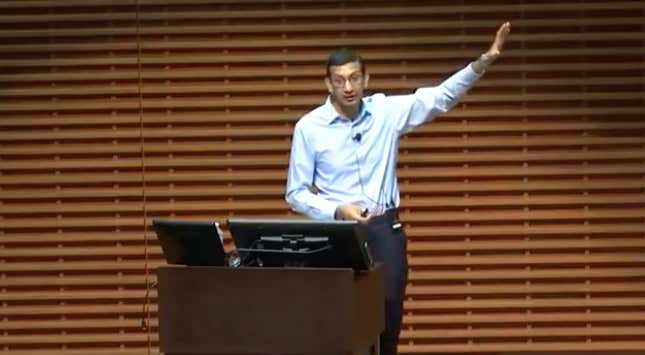Econ 101, the introductory college economics course that is often held in overcrowded lecture halls packed with half-asleep freshmen, is finally getting a facelift.
At the front of the class is Raj Chetty, a 38-year-old economist who publishes some of the field’s most intriguing papers year after year. He’s used data to debunk the American Dream, challenge the Ivies as engines of social mobility, and become an authority on inequality. He’s shuttled from top university to top university, scored a MacArthur “genius” grant, and landed on Forbes’ 40 under 40 list.
Now, at Stanford, he’s rethinking how to teach economics to a bunch of fresh-faced newbies to the field—and they’re loving it.
Chetty’s new class, “Using Big Data to Solve Economic and Social Problems,” attracted 200 students during the spring quarter. It was Stanford’s most popular economics class, with more students than the university’s equivalent of Econ 101 (145).
According to Chetty, come the end of the quarter, some students noted that the class convinced them to major in economics. While Stanford’s economics department confirmed that eight more students are majoring in economics this year compared with last year, it also noted that a number of factors could be contributing to such enrollments, so it’s hard to say whether the bump has anything to do with Chetty’s class. Moreover, since Stanford students do not have to declare a major until their junior year, we may not see the full effect for another year or two.
And now, anyone can take the class—the lecture series is online at The Equality of Opportunity Project.
Supply and demand
The class, in many ways, is a globally engaged, social-minded young person’s dream, with 11 lectures that address how big data is changing the way we think about upward mobility, education, health care, climate change, migration, criminal justice, and discrimination.

What’s more, the class proved popular among people who aren’t usually drawn to economics. According to Chetty, far more women and minorities attended his course, and more came to office hours, which can be intimidating for the uninitiated. The department confirmed that close to half of Chetty’s class was female (84). More women also took Chetty’s class than the Stanford equivalent of Econ 101 (72). His impression is that the class upped the number of female and minority economics majors as well.
Economics is infamously unwelcoming to women and minorities. Of the 79 economics Nobel prizes ever awarded, only one has gone to a woman. Less than one in five tenured or tenure-track economics professors are women, and the gap between the share of women off and on the track remains high (pdf, p. 8). Women in the field are also penalized for teamwork: A study from Harvard found that men were just as likely to get tenure whether they published coauthored papers or not; women, instead, became less likely to gain tenure the more they worked with others.
What gives? There’s some evidence that economics, as a discipline, simply isn’t friendly to women. This summer, a senior at Berkeley used cutting-edge techniques to categorize and study the comments of participants in EconJobRumors.com, an anonymous site used to discuss industry hires and openings. She found that words which best predict a conversation about a man, even if harsh, were typically job-related (“advisor”, “wharton,” “mathematician,” “nobel,” “goals”), but those for women were patronizing, sexual, and unrelated to the field (“hotter,” “gorgeous,” “tits,” “lesbian,” “feminazi”). It revealed, as one economist put it, “a cesspool of misogyny.”
Others blame the level of math in the field. People who are more likely to study math, computer science, or the hard sciences—men—have the deck stacked for them. This reinforces a culture that socializes women and minorities into believing they are less good at math, and consequently leads some to believe that to make economics more inclusive implies making it less technically rigorous.
But that doesn’t seem quite right, since STEM fields are more popular among female and minority undergrads than economics.
Comparative advantage
Indeed, Chetty’s class didn’t shy away from the technical aspects of economics—big data, machine learning, and econometrics—and had no problem attracting women and minority students.
So why did his approach prove so popular?
An experiment at UC Berkeley offered a new PhD minor for engineers explicitly researching solutions for low-income communities: half the engineers in the inaugural class were women. MIT, meanwhile, launched an interdisciplinary lab that focused on building tech to improve the lives of those in poverty, and saw a class that was more than 70% women.
“If the content of the work itself is made more societally meaningful, women will enroll in droves,” believes Lina Nilsson, an innovation director at UC Berkeley and one of MIT Technology Review’s 35 Innovators under 35.
What if this were true in economics, too? Students who grew up in the low-income areas Chetty’s class studied were surprised to see their stories reflected in the field’s research. The professor remembers students filing into office hours and telling him, “I really see myself in these data, in this class.”
Chetty believes the class was ultimately a success because it tackled “things people felt really touched their lives personally, and mattered in terms of what they were reading in the news.”
Of course, the class has only been offered once, so we’ll have to wait and see if its popularity endures (and if those who told Chetty they would declare an economics major stick to it). But Chetty has hope. He’s talking with faculty at other schools to roll out the program more widely.
